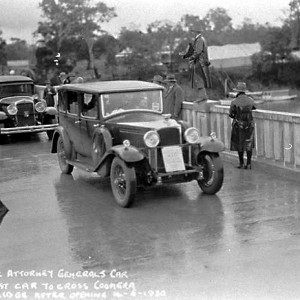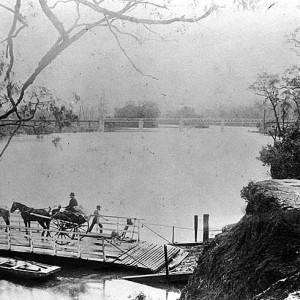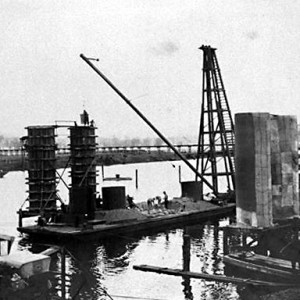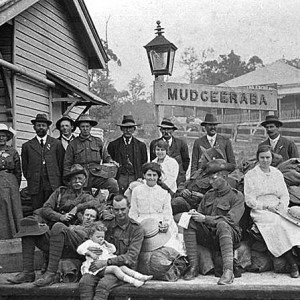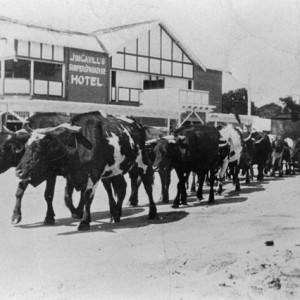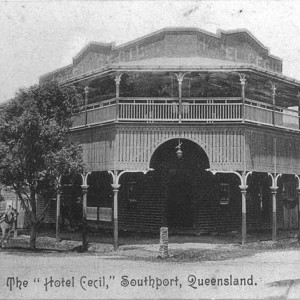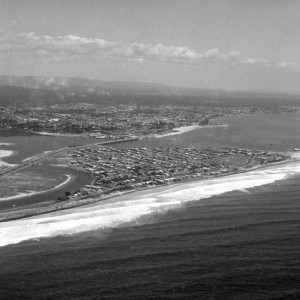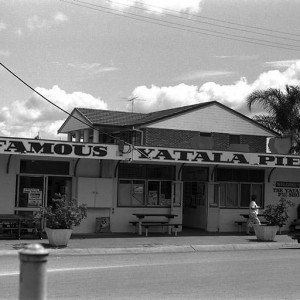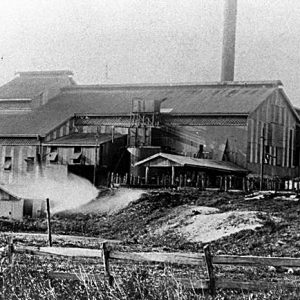
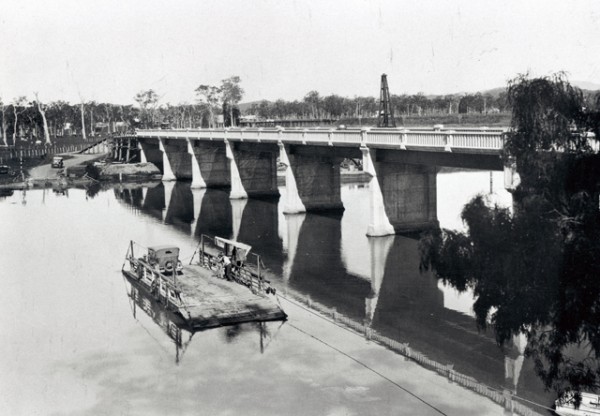
Vehicle Ferry on the Coomera River with the new bridge near completion, circa 1930. Photographer unknown
The Coomera River was previously named the Arrowsmith River by the surveyor Robert Dixon in honour the Arrowsmith family who were cartographers in London and had previously published several maps of New South Wales.
Near the point of the Coomera River where the fresh water of the river mingled with the salt water of the sea, the first Coomera township, originally known as Kemmera or Kummera, was established. Crossing the river was possible by boat or using a rocky ford which allowed people to cross the river on their way between Brisbane and the South Coast. Known as Binstead’s Crossing due to its proximity to the Binstead family home, it was impassable during wet weather and the rainy season.
During the second half of the 1800s the newly created Queensland Government was considering ways to improve the road network to enhance planned railway links. The decision was made that the lower reaches of the Coomera River was better suited as a site to meet future needs of the region.
During the 1870s a punt in this area, located near the Oxenford family property, had been ferrying people and livestock across the river. As a result, it was suggested that the proposed township be called Ferry Township.
In the late 1880s the construction of the railway commenced and an iron lattice bridge with timber trestles carried the steam trains over the Coomera River west of the ferry, before reaching the Coomera railway station.
Rail and ferry crossings continued to meet the needs of travellers through the region until the arrival of motor transport. The popularity of the South Coast, particularly at holiday times, meant an increasing number of vehicles needed to travel the ever expanding road network often resulting in lengthy queues waiting for the ferry crossing. The need for road bridges over the major rivers, including the Coomera River, became a priority.
The road bridge over the Coomera was constructed by M. R. Hornibrook Ltd using predominately local material with the exception of steel bars manufactured at Lithgow NSW and girders that originated from Belgium. The bridge contained 224 girders that were 61½ feet long and 6½ tons each and were the largest solid girders ever imported into Queensland at the time.
The bridge opened on 14 June 1930 with the Attorney General N. F. Macgreaty’s car officially recorded as the first to cross the new bridge. However, according to local legend, it was not the first crossing. The Attorney General’s car had been proceeded a week earlier by two young students from Coomera State School, Vince and Allan Hargraves, who rode their horses over the bridge.
The opening of the bridge was an important event which included a picnic at the site followed by a ‘smoke concert’ at the Grand Hotel in Labrador and an afternoon tea at the Capitol Theatre in Coolangatta. With the opening of the road bridge the ferry crossing was no longer required and, after sixty years, ceased operation.
The Coomera River Bridge is still used to support the service road network next to the bridges of the M1 Pacific Motorway.
Sources of information and further reading
- Longhurst, Robert. Nerang Shire: a history. Nerang: Albert Shire Council, 1994.
- Jones, Michael. Country of Five Rivers: Albert Shire 1788 – 1988. Sydney: Allen and Unwin, 1988.
- Pugh’s Almanac and Queensland Directory, 1867.
- Coghill, Gloria. 125 years of Schooling on the Coomera 1873-1998. Wonga Wallen, G. Coghill, 1998.
- “The early settlement of the Logan and Albert districts.” Journal of the Royal Historical Society of Queensland volume 2 issue 5: pp. 208-262.
- Hanlon, William E. Brisbane, Qld. Royal Historical Society of Queensland, 1935.
- Official Notifications. (1874, July 27). The Brisbane Courier (Qld. : 1864 – 1933) p. 3. http://nla.gov.au/nla.news-article1386282
- Coomera Bridge. (1928, November 25). Sunday Mail (Brisbane) (Qld. : 1926 – 1954) p. 26. http://nla.gov.au/nla.news-article128503953
- Coomera Bridge. (1930, June 11). The Brisbane Courier (Qld. : 1864 – 1933) p. 12. http://nla.gov.au/nla.news-article21552783
- Coomera Bridge Opening. (1930, June 15). Sunday Mail (Brisbane) (Qld. : 1926 – 1954) p. 18. http://nla.gov.au/nla.news-article97672217
- IMPORTANT LINK. (1930, June 16). Morning Bulletin (Rockhampton, Qld. : 1878 – 1954) p. 8. http://nla.gov.au/nla.news-article55369791
- [No heading]. (1930, June 20). South Coast Bulletin (Southport, Qld. : 1929 – 1949) p. 2. http://nla.gov.au/nla.news-page15964464
